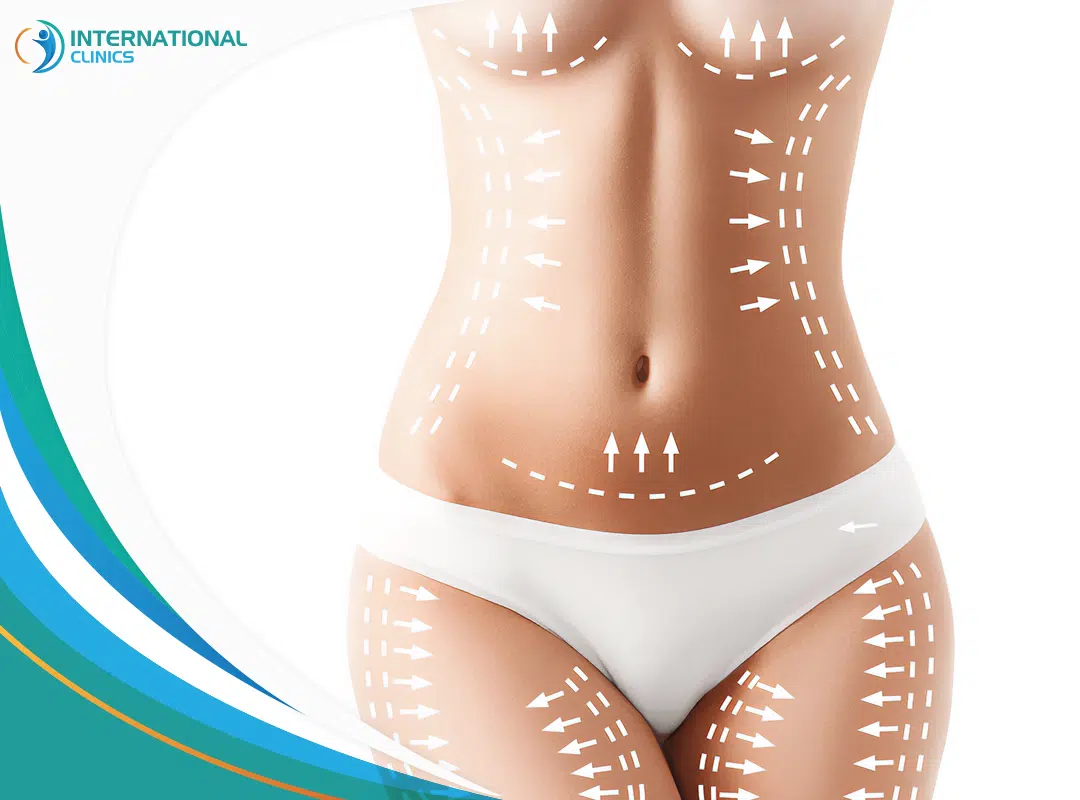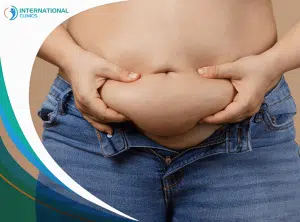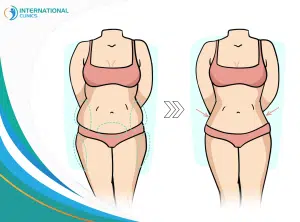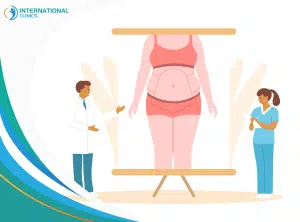Liposuction, also known as liposculpture, is a very common plastic surgery dedicated to fat removal and helping people achieve a more balanced body shape. During the procedure, a plastic surgeon can permanently eliminate fat cells from a specific area of your body that you wish to enhance.
Often, liposuction targets stubborn fat deposits that are unresponsive to diet and exercise and is used to reshape areas such as the abdomen, hips, thighs, and buttocks, alongside other body regions.
In 2021, liposuction took the lead as the most prevalent cosmetic surgery, surpassing breast augmentation. In fact, there were over 1.9 million liposuction procedures performed in that year, representing a significant increase of 24.8%.
People often choose liposuction in Turkey because it offers a lasting solution for battling stubborn fat deposits, ultimately contributing to a more proportionate and slimmer physique. In this guide, we’re going to review the areas that can be targeted by the procedure, the types of liposuctions, the cost of liposuction, and other important topics.
Understanding Liposuction Surgery
Liposuction is a medical technique that suctions away extra fat from your body with high precision. It doesn’t replace weight loss, however, but it can reshape your body.
This procedure helps change the appearance of specific areas by removing fat from them. The common areas for liposuction include the thighs, buttocks, abdomen, arms, neck, and under the chin. It’s also done on the back, waistline, inner knee, chest, cheeks, calves, and ankles.
Interestingly, liposuction has been around since 1974 when two Italian doctors, Arpad and Giorgio Fischer, developed a unique method for fat removal. However, the procedure has gone through many changes in terms of techniques and surgical methods.
Liposuction is a reliable way to get rid of stubborn fat that doesn’t go away with diet and exercise. If a doctor isn’t a specialized plastic surgeon, they might still perform liposuction, but they might not have the same level of expertise needed to bring good results.
Therefore, when choosing a surgeon for liposuction, it’s always better to ask them lots of questions about the procedure, their experience, and qualifications.
Liposuction Areas
Liposuction can help you slim down and shape various areas of your body. In short, it can target specific spots in the body where stubborn fat tends to accumulate, including:
- The abdomen and waist: If you’ve got extra fat around your midsection (abdomen and waist) that resists other conventional solutions, liposuction can help solve the matter.
- Back: Love handles or back rolls can be contoured and reduced through liposuction techniques.
- Upper arms: The flabby upper arms are no longer hard to tone or tighten, thanks to liposuction.
- Chest (breast): Men dealing with gynecomastia or women with excess breast fat can choose liposuction to solve these problems.
- Calves and ankles: If you’re extremely bothered by chunky calves or thicker ankles, liposuction can give you more toned legs.
- Face, cheeks, chin, and neck: Liposuction can sculpt your face and let go of the unwanted fat in your jawline and chin areas.
- Hips and buttocks: You can enhance your body’s curves by removing extra fat from your hips and buttocks, which is commonly desirable by women.
- Thighs: Liposuction can create slimmer and shapelier thighs by reducing fat deposits.
- Inner knee: The fat pockets on the inner side of your knees can also be targeted by liposuction.
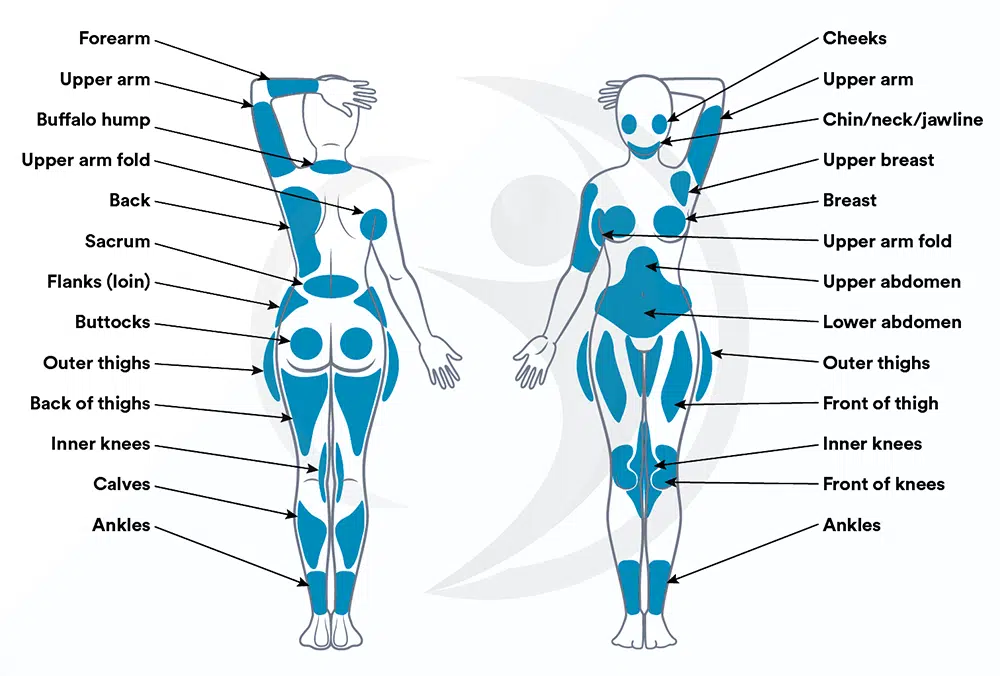
Get your free medical consultation now!
Types of Liposuction Surgery
Liposuction surgery can be done through different techniques or methods. The main liposuction techniques include:
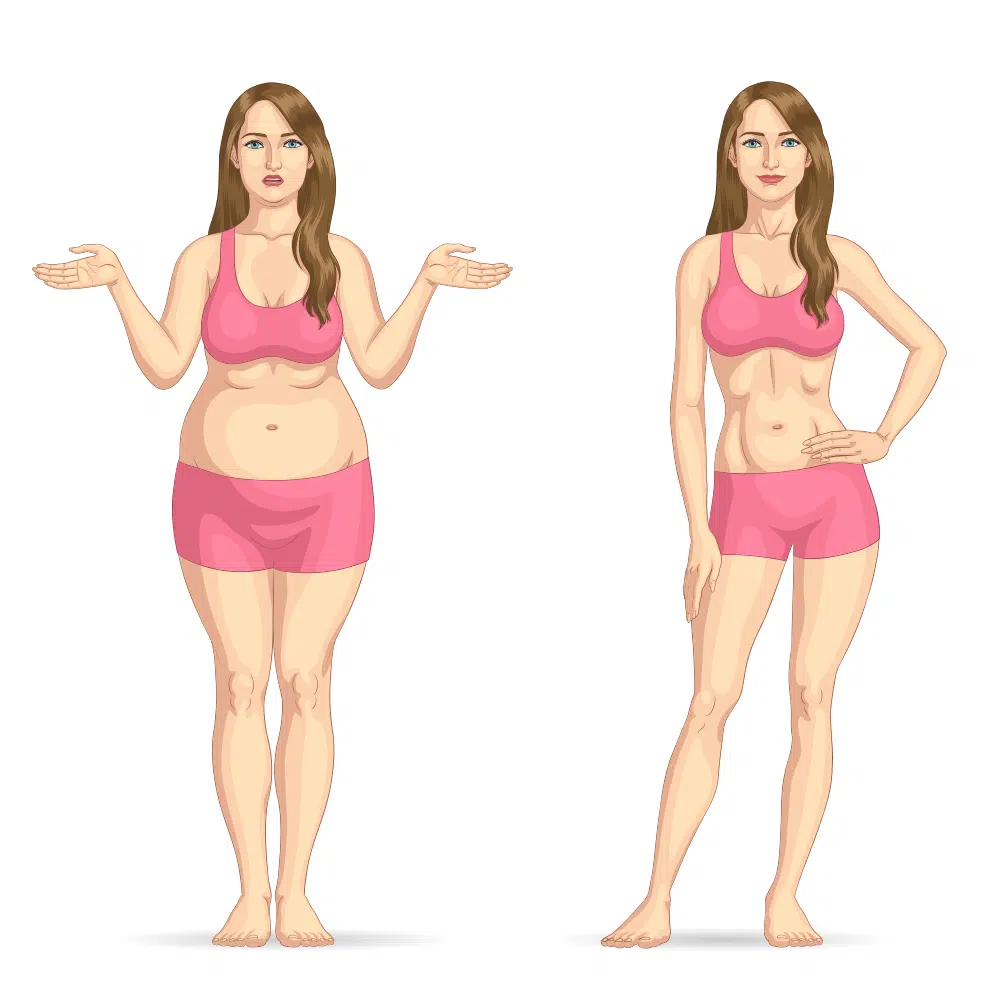
Traditional Liposuction
Traditional liposuction is relatively old yet remains a reliable method to remove fat. Surgeons make tiny cuts and stick a suction probe to suction that fat out of the body. Since it’s a “traditional” liposuction, don’t expect to see gimmicky or advanced technological tools during the procedure such as VASER or laser liposuction.
Traditional liposuction is effective for people with a higher BMI. Plus, it can remove a good chunk of fat either in its own or alongside other cosmetic surgery such as tummy tuck.
Tumescent Liposuction
Interestingly, the widely practiced cosmetic procedure in the United States is actually tumescent liposuction, which stands out for its effectiveness, safety, and reduced discomfort compared to traditional liposuction.
Moreover, it offers a faster recovery and only involves injecting a saline solution infused with adrenaline and local anesthesia to remove the fat. This injection causes the targeted area to swell and become firmer.
The procedure is typically conducted on an outpatient basis and doesn’t necessitate general anesthesia. In short, it provides a more secure alternative while still delivering satisfying outcomes.
Another notable benefit of this technique is its potential to reduce significant shifts in bodily fluids that can sometimes occur after the removal of a substantial volume of fat, which reduces the risk of low blood pressure.
Laser-Assisted Liposuction
This innovative method is centered around using laser energy to target fat tissue, followed by the application of laser-induced thermal effects to tighten the skin. Subsequently, a suction machine is used to extract the liquefied fat.
This procedure is specifically recommended for the removal of localized fat deposits in smaller facial and bodily regions that are challenging to other liposuction techniques.
This combination of laser-assisted fat removal and skin tightening is a desirable option for those seeking effective solutions to enhancing the appearance of areas such as the double chin, arms, and the inner sides of the knees.
One advantage is the immediate skin-tightening effect, especially in areas like the hips. Patients often witness visible results right away.
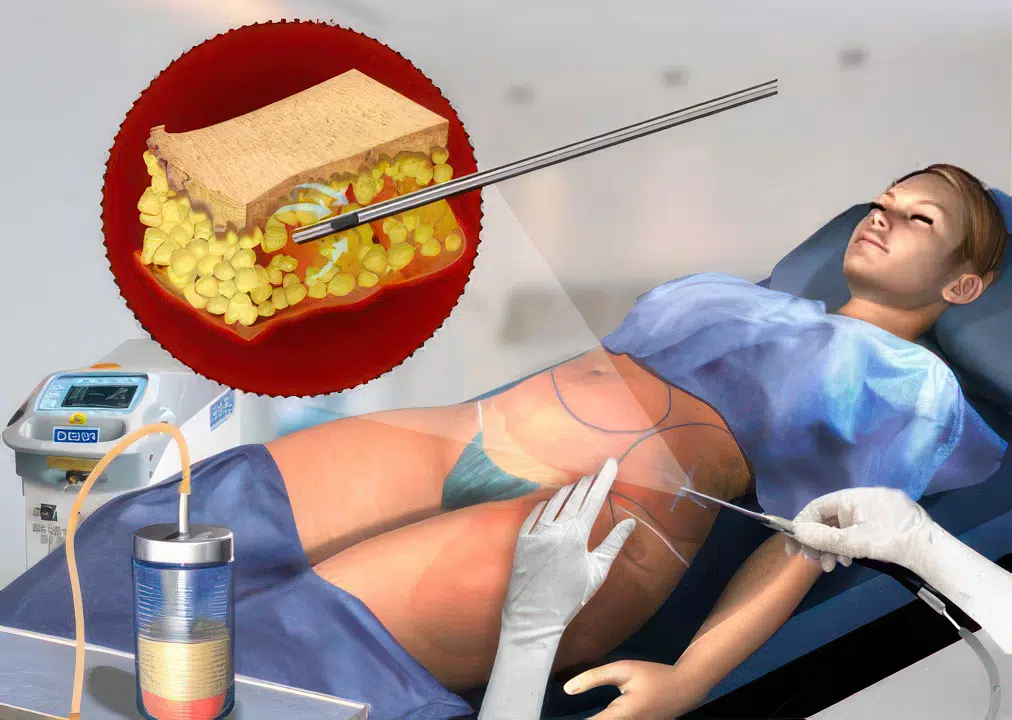
Power-Assisted Liposuction
Power-assisted liposuction is a remarkable advancement in the fat reduction arena as it incorporates traditional liposuction methods alongside a vibrating-tipped cannula, resulting in a swifter and more effective fat removal process.
This method can provide a smoother and gentler experience in comparison to the conventional liposuction procedure. Some experts even consider power-assisted liposuction as a variant of high-definition liposuction (similar to VASER liposuction).
Power-assisted liposuction works by breaking down fat cells and loosening fat deposits, making it easier to remove while causing minimal damage to the surrounding tissue.
Ultrasound-Assisted Liposuction
Ultrasound-assisted liposuction (UAL) uses ultrasound waves to break down and liquefy fat cells. The goal is to make them more easily removable and offer the added benefit of mild skin tightening.
The whole procedure relies on a cannula that emits safe sound waves from its tip. These soundwaves effectively transform fat into a liquid state without causing harm to surrounding tissues.
Ideal candidates for this technique are those grappling with stubborn fat deposits that prove resistant to conventional diet and exercise methods. These candidates must be in good overall health and maintain realistic expectations regarding the outcomes.
The ultrasound waves prove effective for areas with higher fat cell density or larger fat deposits. Furthermore, these waves contribute to mild skin tightening and skin retraction, which enhances the overall aesthetics of the treated areas.
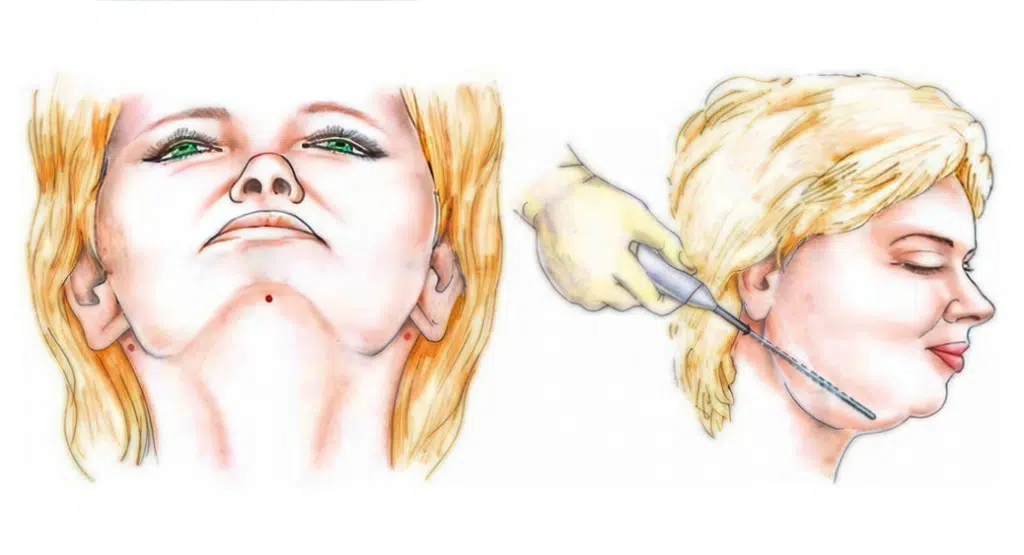
Water-Assisted Liposuction
This innovative liposuction technology eliminates the need for general anesthesia, which of course reduces both patient risks and costs. Moreover, it incorporates a fluid management system that enables the surgeon to perform a more comprehensive anatomical assessment during the procedure, leading to better results.
Instead of relying on laser energy to liquefy and dislodge fat cells, this method employs a pressurized stream of saline solution to break down and eliminate fat deposits. Unlike procedures that obliterate fat cells, water-assisted liposuction gently loosens these cells and facilitates their removal.
Liposuction Surgery Prices
The cost of liposuction differs depending on where you decide to have the procedure done. In the US, the national average is around 4,000 US dollars. Remember again that this is just an average as prices can fluctuate considerably even in the same country. Liposuction cost in Turkey is known as the cheapest on the map.
For instance, in larger cities like New York and Los Angeles, you might find the costs soaring, primarily due to the presence of highly skilled plastic surgeons who charge more for their services. Areas with a high cost of living tend to have higher liposuction prices, too.
Furthermore, the cost of liposuction isn’t just about the surgery itself. There are several additional expenses or side factors you should consider. These include medical tests, anesthesia fees, the surgical facility, and the medications after the surgery.
When it comes to insurance, most insurance companies refuse to cover liposuction because it’s seen as a cosmetic procedure in most cases and not a medical necessity.
However, there could be rare exceptions where insurance may cover it. This typically happens when there’s clear evidence that the procedure has therapeutic benefits, like reducing chronic back pain through surgical breast reduction. In any case, below is a list of different countries and their estimated liposuction costs:
| Country | Av. Price per area | Country | Av. Price per area |
| Turkey | 1500 – 1800 US dollars | Mexico | 2000 – 2200 US dollars |
| Costa Rica | 2050 – 2400 US dollars | Latvia | 2000 – 2350 US dollars |
| Estonia | 2000 – 2300 US dollars | Spain | 2500 -3300 US dollars |
| Poland | 2500 – 3000 US dollars | Romania | 2000 – 2200 US dollars |
| Germany | 3000 – 4500 US dollars | India | 1900 – 2100 US dollars |
| Thailand | 2000 – 2300 US dollars | South Korea | 2300 – 2500 US dollars |
| United Kingdom | 4000 – 5200 US dollars | United States | 3500 – 5000 US dollars |
Comparisons with Other Body Contouring Procedures
To help you make the right decision, we must explain the differences between liposuction and other similar techniques to reduce fat in the body.
Liposuction vs. Tummy Tuck
Although they employ distinct techniques, both tummy tuck and liposuction aim at slimming down the stomach. On one hand, liposuction uses a cannula and vacuum-like tool to extract stubborn fat that diet and exercise can’t eliminate from the belly.
In contrast, abdominoplasty (or tummy tuck) not only removes excess fat but also eliminates skin and tissue and tightens the abdominal muscles. In other words, liposuction isn’t capable of addressing excess skin.
Both tummy tuck and liposuction, however, aren’t weight loss procedures and will not result in significant weight loss. Instead, they focus only on localized fat reduction.
Liposuction vs. CoolSculpting
For those looking for a non-surgical solution to reduce fat in specific regions like love handles or outer thighs, CoolSculpting could be the ideal choice. In short, the CoolSculpting device is designed to address localized pockets of fat and help you see a mild to moderate enhancement in the treated area.
In contrast to CoolSculpting, liposuction is a surgical intervention. It uses a suction method to eliminate fat from targeted zones.
These zones overlap with those typically treated by CoolSculpting, which include the abdomen, thighs, arms, and neck. However, liposuction can also be applied to remove fat from additional areas not accessible with CoolSculpting, including areas such as the knees and the face.
Liposuction vs. Fat Transfer
Liposuction is a surgery that removes fat through small incisions and suctions it out with a special device. On the other hand, fat grafting is a surgery where fat is taken from one part of the body and injected into another to add more volume to the targeted area. Obviously, each of these procedures has its own goal and set of advantages and disadvantages.
It isn’t unusual to undergo comprehensive body contouring by combining liposuction and fat transfer. Some common combinations are fat grafting to the buttocks and fat grafting to the breasts. These combinations can offer more extensive and balanced results for patients seeking to enhance their appearance.
Liposuction vs. Body Lift
The goal of a body lift is to enhance the firmness and contour of the tissue that supports your skin and fat. This procedure involves the removal of excess skin and fat to address issues related to poor tissue elasticity.
The concept behind body lifts emerged because there are situations where exercise alone can’t battle sagging skin or uneven body contours.
If your primary concern is sagging in these areas and not necessarily the removal of fat cells, a body lift is the right choice for achieving the desired results.
However, if your skin is already smooth and tight or you’re just looking to address fat deposits, then liposuction could be a more suitable option for you.
Liposuction Surgery Requirements & Devices
Surgeons often rely on using specialized sets or kits of tools to perform liposuction procedures. These sets differ according to the chosen liposuction technique (laser, ultrasound, etc.).
In general, these sets are specifically designed to equip surgeons with the essential tools required for liposuction procedures, guaranteeing both efficiency and durability.
Each set comprises a range of top-notch surgical instruments crafted from premium stainless steel to ensure longevity. These tools offer surgeons the precision and accuracy for safe and successful liposuction procedures.
Additionally, they are ergonomically fashioned to reduce noise, minimize vibration, and maintain a surgical environment, enabling precise targeting of the areas for suctioning.
The Liposuction fat-removal surgery kit may include:
- Cannulas: These are thin tubes used to extract fat from targeted areas. They come in different sizes and thicknesses and may be made of different metals.
- Syringes: Syringes are used to inject or withdraw fluids. In liposuction, they’re primarily used to inject a special solution into the fat tissue to make it easier to remove.
- Scissors: Surgical scissors are used for cutting and shaping the tissues during the procedure.
- Retractors: Retractors are used to hold back tissues or organs in order to provide better access to the targeted fat deposits.
- Suction Tubes: These tubes are essential for suctioning out the emulsified fat.
- Forceps: Forceps are used for grasping and holding tissues.
Side Effects and Risks
Although highly safe, liposuction also comes with certain risks, at least in some cases. However, you can take steps to reduce these risks by choosing a clinic that only hires highly trained, board-certified cosmetic surgeons. In any case, the risks associated with liposuction may include:
- Bleeding: Excessive bleeding during or after the procedure may occur, depending on the original health.
- Anesthesia complications: Problems related to liposuction anesthesia may arise in those sensitive to anesthetic agents.
- Fluid accumulation: Pockets of fluid might form beneath the skin, which can be highly problematic for surgeons.
- Infections: Infections caused by bacteria like streptococcus or staphylococcus are possible too.
- Fat embolism: Small masses of fat can break away and obstruct blood flow, leading to fat embolism in certain regions of the body.
- Shock: This risk can result from inadequate fluid intake during surgery, which often leads to a drop in blood pressure.
- Burns: Instruments used during the procedure can sometimes cause burns, especially when laser devices are used.
- Uneven fat removal: There’s a risk of removing fat but not in all targeted places, leading to irregular results.
- Change in skin sensation: You might experience changes in skin sensation, including numbness.
- Damage to organs: In rare cases, some vital body parts may receive damage during the procedure, including nerves and muscles.
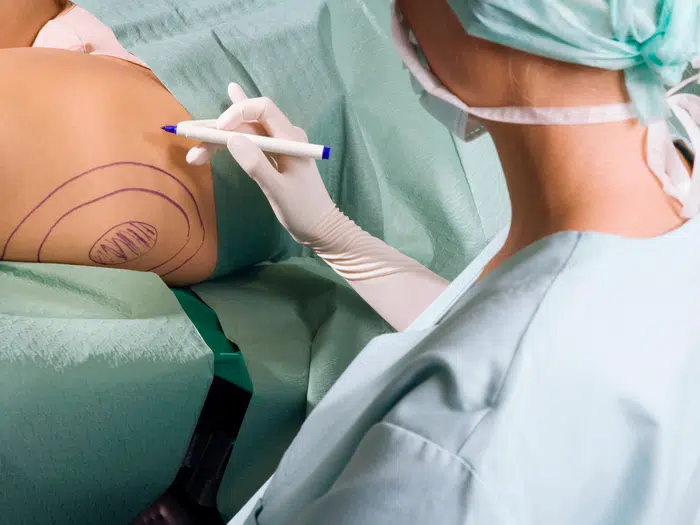
Contraindications
Liposuction demands patients to be in good health overall. In contrast, those with severe medical issues such as heart disease, diabetes, or liver problems may not be suitable candidates for liposuction.
Liposuction isn’t a method designed for weight loss in the first place. If you’re overweight or obese, it’s better to focus on shedding those extra pounds through diet and exercise to reach your desired body weight and maintain it before thinking about liposuction. Surgeons often decline to perform liposuction for various reasons, including:
- Smoking: Smoking significantly elevates the risk of complications. Whether you’re a regular smoker, a vaper, or an occasional marijuana user, it can put you in a higher-risk category for liposuction due to its negative impact on your circulatory system.
- Inappropriate for weight loss: Overweight or obese individuals are advised to shed excess weight through diet and exercise before considering liposuction. Surgeons often decline to perform the procedure if your Body Mass Index (BMI) score isn’t within the required range (above 30).
- Unrealistic expectations: Liposuction is about body contouring only. It cannot address visceral fat, which is fat around internal organs. Only weight loss can effectively tackle this type of fat.
- Inappropriate skin quality: The success of liposuction depends on the quality of your skin. If your skin is loose or has cellulite, removing the underlying fat may worsen its appearance.
- Existent diseases: Even if you feel healthy, underlying medical conditions can disqualify you from surgery. Conditions like asthma, diabetes, and high blood pressure are red flags for plastic surgeons.
Pros & Cons of Liposuction Surgery
We can list both the pros and cons of liposuction surgery as follows:
Pros of Liposuction Surgery
- Achieve your desired body contours: Despite your efforts at the gym, certain areas of our body tend to stubbornly hold onto excess fat, making it difficult to target them with exercise and diet alone. Liposuction can effectively reduce fat in these areas. These often include the abdomen, hips, thighs, male chest, back, and arms.
- Permanently eliminate fat cells: One of the most highly regarded advantages of liposuction is its ability to permanently remove fat cells from treated areas. Once these fat cells are gone, they won’t regenerate, which provides enduring results.
- Reveal your hard-earned muscle definition: If you’ve invested time and effort in strength training, you may feel stronger, yet a layer of stubborn fat may continue to obscure your muscle definition. Liposuction can remove this fat layer, unveiling the sculpted physique you’ve worked so diligently to attain.
- Enhance your self-confidence: Many people grapple with body image concerns due to persistent fatty deposits that seem resistant to traditional methods. By eliminating these fat cells and creating a more contoured appearance, liposuction can boost self-esteem, leading many people to feel more self-assured in their clothing and swimwear.
- Meet many preferences: Liposuction offers an impressive level of versatility and customization. You can target multiple areas in a single procedure or combine liposuction with other body contouring or breast enhancement options to achieve a tailored outcome.
- Minimal recovery required: One significant benefit of liposuction is its minimal recovery time. You won’t need to commit to an extended period of downtime. In most cases, individuals typically require just one week away from work and daily activities to return to their regular routines.
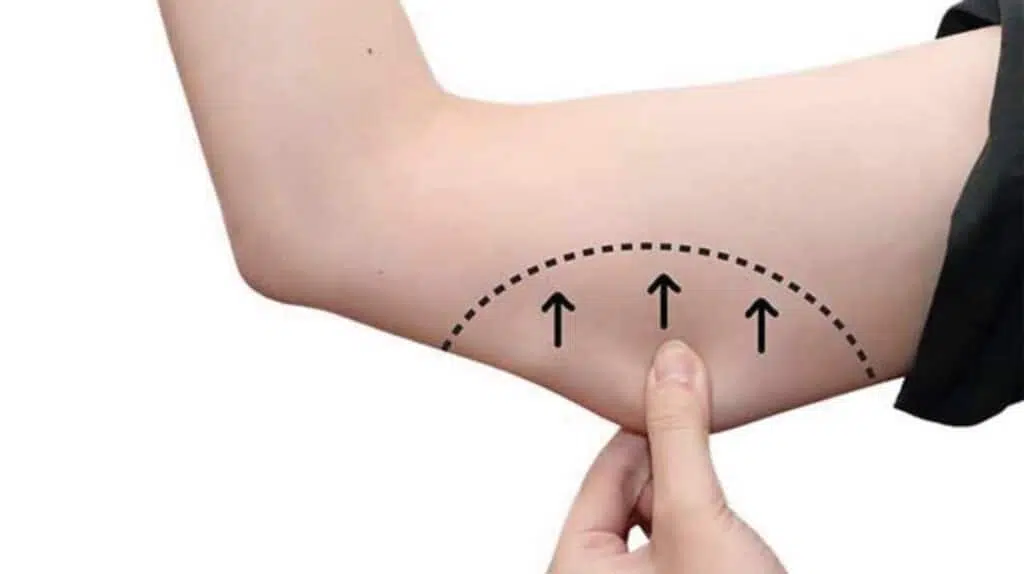
Cons of Liposuction Surgery
- Weight gain after liposuction: To maintain weight loss after liposuction, you need to follow a healthy diet and exercise regularly. Some patients mistakenly believe that fat removed during liposuction won’t return, but this isn’t the case all the time.
- Swelling after the procedure: While liposuction is less invasive than some other procedures, it’s normal to experience swelling afterward. Thankfully, however, swelling usually decreases within a month, but in some cases, it can persist for up to six months.
- Loose skin concerns: Older patients may face loose skin issues after the removal of fat cells.
- Potential internal injuries: Although rare, one possible complication of liposuction is the accidental puncturing of organs or blood vessels, particularly if the cannula is positioned too deeply.
- Risk of removing excessive fat: A common risk associated with liposuction is removing too much fat in a single session. Different surgeons have varying recommendations regarding the safe amount of fat that can be removed.
- General surgery risks: Like any surgical procedure, liposuction involves incisions and anesthesia, and it’s important to consider these surgical risks before proceeding.
Speak with certified surgeons and medical consultants!
Liposuction Results and Before & After
The period needed for a complete liposuction recovery differs between cases depending on the original health condition of the patient and other factors.
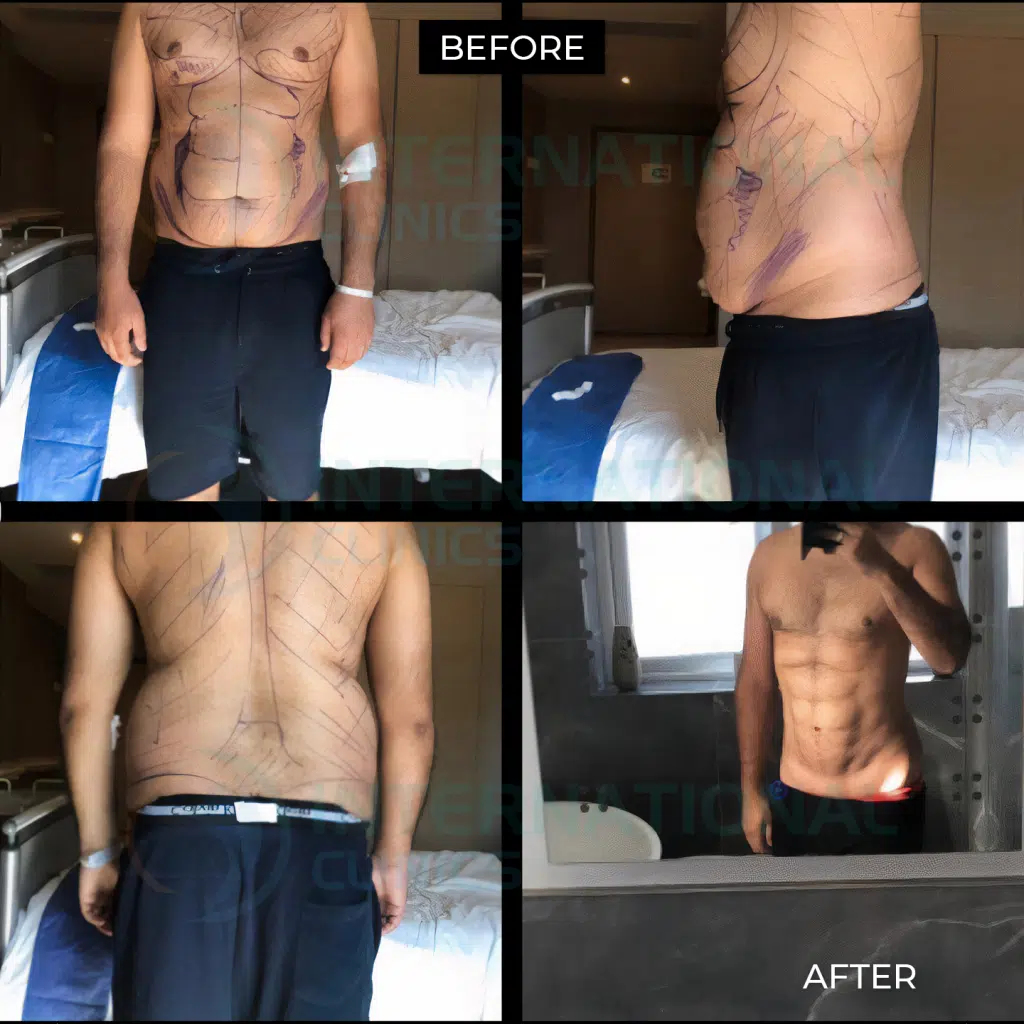
Immediately After Liposuction
Following your treatment, you may notice some swelling, which can temporarily obscure the results of your liposuction. This swelling should start to disappear within a few weeks. Besides, you may also feel localized pain, which can be resolved using painkillers.
Days After Liposuction
During the initial days after your surgery, you might experience inflammation and water retention. However, this is a normal part of the recovery process and not a cause for concern.
Depending on the amount of fat removed and the degree of skin looseness prior to surgery, you may observe some looseness in the skin around the treated area. Over time, the skin will naturally tighten around your newly contoured body.
The extent of this skin tightening can vary, depending on factors such as the type of liposuction performed, your skin’s elasticity, and how consistently you wear the compression garments. That’s why it’s very important to follow the instructions provided by your surgeon.
Months After Liposuction
Around a month after your liposuction, you’ll typically experience minimal or no pain. Some residual swelling may persist, however, and it might take several months to completely subside.
As the swelling and bruising gradually diminish, you’ll start to see improved results. Most individuals can engage in moderate exercise after four weeks but be sure to avoid any strenuous or intense physical activities during this period.
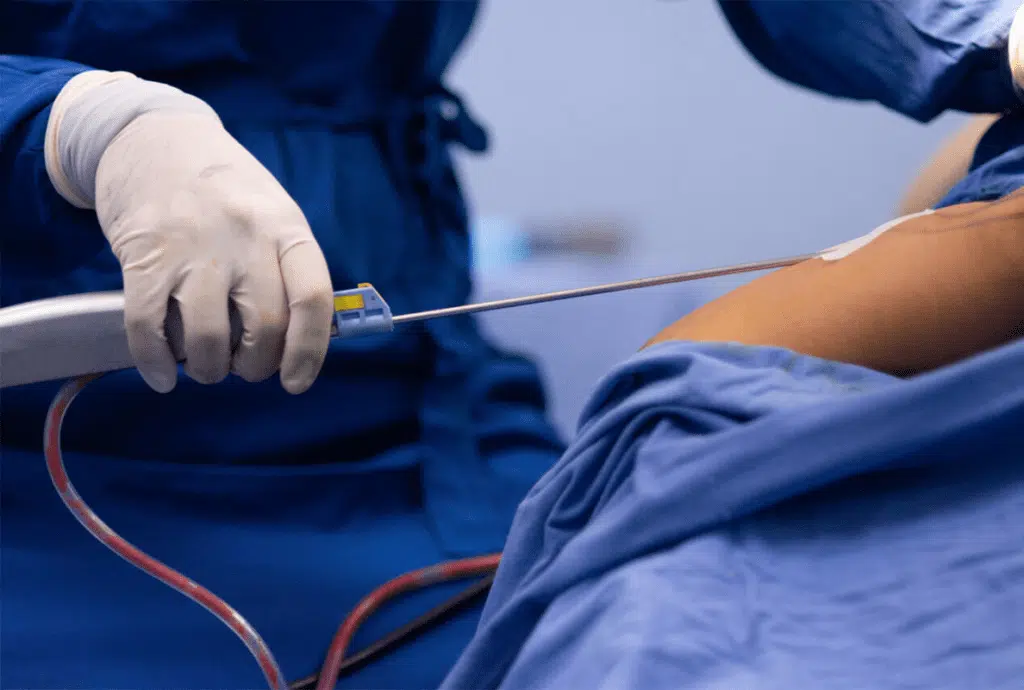
Traces & Scars
After liposuction procedures, some patients may notice very minor scarring once they are fully healed. Indeed, the scars are one of the most worrisome liposuction risks that lead many people to refuse the surgery altogether.
However, these scars are typically hidden and generally minimal because surgeons make small incisions to accommodate the insertion of slim cannulas for fat extraction.
Many patients report that these scars take the shape of tiny blemishes after their skin fully heals. Thankfully, there are many treatments available to address the surgical scarring.
- Chemical peel: This treatment exfoliates the upper skin layers, which aids in scar tissue removal.
- Silicone gel sheets: This is a cost-effective and user-friendly option for scar management that can be applied at home.
- Laser treatments: This therapy uses heat to break up scars and promote the growth of new skin cells.
- Microdermabrasion: A method of manual exfoliation that removes scar tissue and stimulates collagen production for smoother skin.
- Scar revision surgery: In cases of more severe and visible scarring, scar revision surgery can be considered.
Liposuction in Turkey
Turkey has started to prove its worth in the medical tourism arena, thanks to its high healthcare standards, excellent safety records, and a growing number of satisfied patients. People often choose Turkey for liposuction for the following reasons:
- Cost-effective option: One reason to consider Turkey for liposuction is the remarkable price advantage it offers. Patients from the UK and Europe, in particular, can save a substantial amount compared to their home countries.
- Quality healthcare facilities: Turkey hosts different private hospitals and medical clinics with contemporary facilities and vacation-like surroundings. These facilities are well-equipped, maintain high standards of hygiene, and largely meet the globally recognized safety protocols for surgical safety.
- Highly skilled surgeons: Surgeons in Turkey are usually informed on in the latest liposuction techniques and use the right technologies to remove fat cells. In fact, many of them have a proven track record of delivering natural-looking results for both local and international patients.
- Vacation opportunity: Turkey offers a unique opportunity to enjoy a memorable holiday before and after your liposuction procedure. You can relax and recover in the comfort of Istanbul and other major Turkish destinations.
Read more about Liposuction in Turkey
Patient Reviews & Hospitalization
International Clinics have received thousands of patients who chose to undergo different types of liposuction procedures. Some of the testimonials they lift are below (We kept our patients’ names anonymous for privacy reasons):
Patient (A)
“When I reflect on the outcome of my liposuction procedure at International Clinics, I am quickly overwhelmed with gratitude. Really, it was a cool experience! Right from the moment I stepped into their facility, the staff received me easily and I felt completely safe. Dr. Mustafa has amazing expertise in liposuction. The transformation in my body has far exceeded my expectations and now I feel like a whole new human being. I can’t express my appreciation enough for the confidence you’ve restored in me!”
Patient B
“My experience with stomach liposuction was easier than I used to think! The team has exceptional skills and a remarkable degree of care. They addressed all my inquiries and gave me the attention that I hoped to get. The liposuction results went far beyond my initial hopes, and I am happy with the outcome. I can comfortably recommend the clinic to anyone seeking true body transformation.”
Patient C:
“I can’t emphasize enough how thankful for knowing International Clinics. In the beginning, I felt a bit worried, but the doctors in the clinics immediately alleviated my concerns. I got the results that I expected from my liposuction procedure, and now I feel confident and content. I believe you have altered the course of my life, and for that, I extend my thanks!”
FAQs – Frequently Asked Questions
Liposuction costs between 1700-2000 US dollars in Turkey. In the United States, the cost can go up to 4000 US dollars, and that’s also possible in other countries such as Canada, UK, and Australia.
Some of the risks associated with liposuction include abnormal skin sensations, infection, bruising, swelling, fluid accumulation, anesthesia risks, irregular contours, and others.
The recovery period is that period of time that comes after the surgery and may last between a couple of days to 3 weeks, and sometimes to multiple months and even a year.
Liposuction isn’t a treatment for obesity and shouldn’t be used for this reason. It’s only a body contouring procedure that targets specific areas in the body.
Non-surgical alternatives to liposuction include CoolSculpting and cryolipolysis among others. Although less effective, these options are still available to many people.
Conclusion
Liposuction can successfully remove excess fat from different body areas like the belly, thighs, buttocks, back, etc. Indeed, it can both get rid of fat and sculpt these areas to give them a better shape.
Liposuction is typically done as an outpatient procedure with local anesthesia, but if you’re having other surgeries like a tummy tuck, general anesthesia might be necessary.
If you’re significantly overweight, we recommend you continue your weight loss journey. For the best liposuction results, it’s better to maintain your target weight for at least six months before the procedure.
In cases of large-volume liposuction, it’s better for patients to stay in the hospital. Depending on the areas treated and the extent of sculpting, you might need small drains for a few days to remove excess surgical fluids and blood.
After the procedure, you’ll wear special garments and foam compression to minimize swelling and help achieve a smoother and more defined body contour.
International Clinics can help you decide whether liposuction is the right option for you or not. You can contact us directly using the Contact Us buttons on our website.
